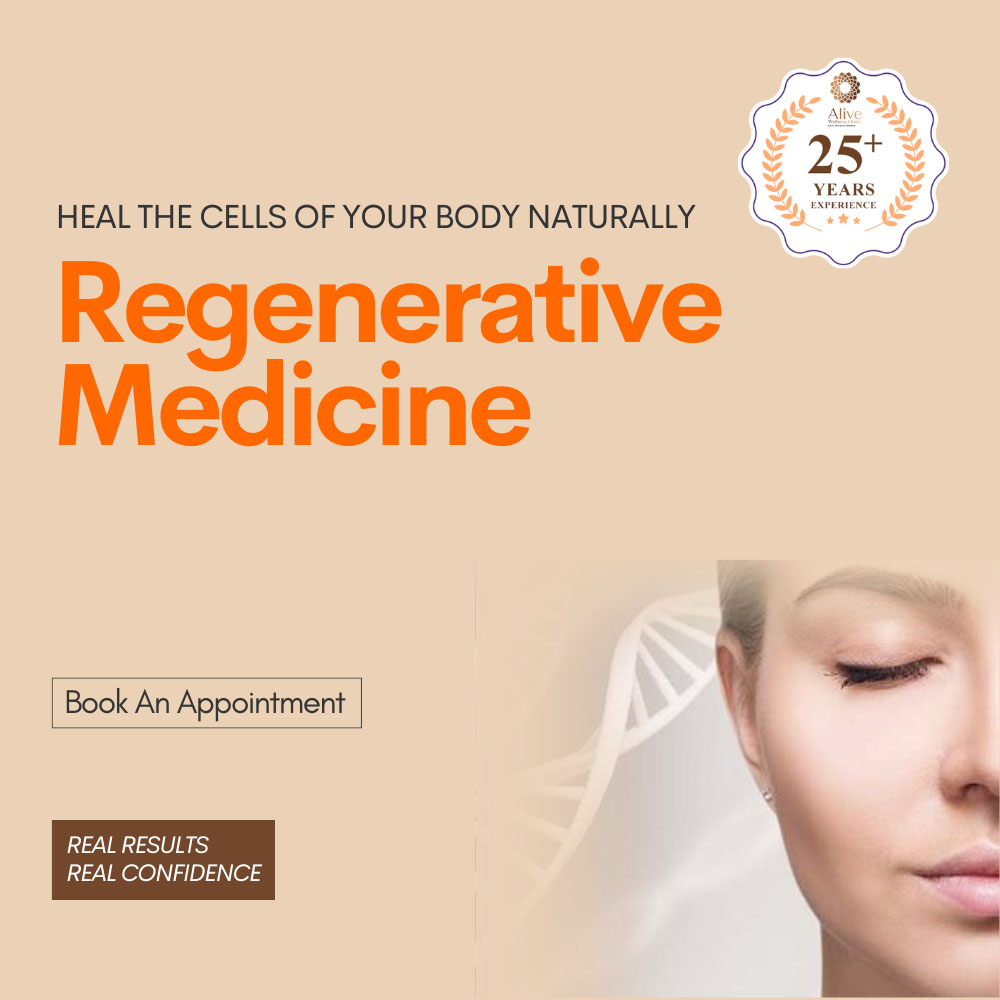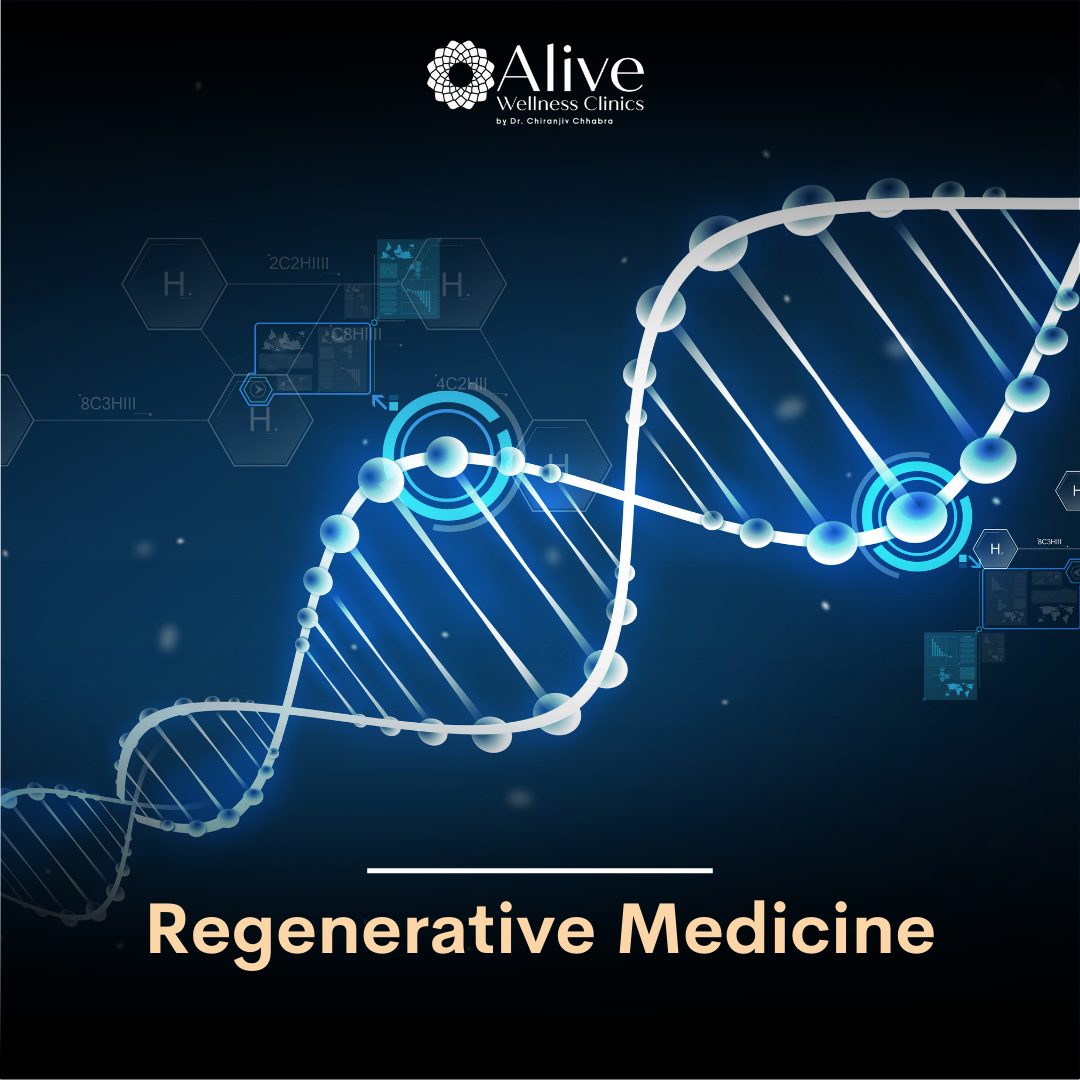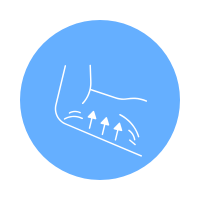
Regenerative Medicine
Regenerative medicine represents the science of restoring injured tissues (or organs) to their original form and function. It relies on the remarkable abilities of the stem cells, which have the unique ability of self-renewal which is the ability to differentiate into specialized cells, thus sidestepping the usual healing by scar formation. While the regenerative capacity in adults is notably modest regenerative medicine holds the promise of unlocking and harnessing the latent potential of cells to regenerate tissues and organs.

While we all embrace ageing and the wisdom it brings, it’s undeniable that the physiological and aesthetic changes that accompany it can sometimes be challenging. These changes can leave us feeling less vibrant and seeing a reflection that, while still lovely, might appear a bit weary.
Fortunately, the field of regenerative medicine is offering exciting new possibilities to mitigate these effects. By harnessing the body’s natural healing processes, these treatments can help repair, restore, and rejuvenate tissues. This natural evolution in aesthetic treatments promises to help us age gracefully, maintaining a youthful appearance and a vibrant spirit.
What is Regenerative Medicine?
Regenerative medicine is a cutting-edge field in healthcare that focuses on repairing, restoring, or even regenerating human cells, tissues, or organs to restore their normal function. Unlike traditional treatments that primarily manage symptoms, regenerative medicine targets the root causes of diseases and injuries by harnessing the body’s inherent healing abilities. This innovative approach has the potential to revolutionise the treatment of a wide range of conditions, from acute injuries to chronic diseases, and even those previously considered untreatable.

Regenerative Treatment In Delhi
At its core, regenerative medicine encompasses various groundbreaking techniques. One of the most prominent is stem cell therapy, which utilises stem cells—unique cells capable of differentiating into multiple specialised cell types—to repair or replace damaged tissues.
What distinguishes regenerative medicine is its emphasis on stimulating the body’s natural repair processes. Instead of merely treating symptoms, it aims to restore function to compromised tissues and organs. This revolutionary approach offers hope for numerous conditions currently lacking effective treatments, such as heart disease, neurodegenerative disorders, and certain cancers. As research advances, regenerative medicine continues to expand the horizons of healthcare, promising personalised therapies that could transform patient outcomes across various medical fields.
Regenerative medicine is poised to reshape the landscape of healthcare, offering hope for patients with a wide range of conditions, such as:
- Neurodegenerative Diseases: Repairing damaged nerve cells to treat conditions like Parkinson’s disease and Alzheimer’s.
- Heart Disease: Regenerating heart tissue to restore function after heart attacks.
- Orthopaedic Injuries: Healing damaged cartilage and bone to alleviate chronic pain and improve mobility.
- Diabetes: Replacing damaged insulin-producing cells to treat type 1 diabetes.
As research continues to advance, regenerative medicine is on the brink of unlocking the body’s full healing potential, ushering in a new era of personalised and effective treatments.
What is Regenerative Aesthetics?
Regenerative aesthetics is a cutting-edge approach that leverages the body’s natural healing processes to restore a youthful appearance. Unlike traditional cosmetic procedures, it focuses on stimulating the skin’s regenerative capabilities rather than masking imperfections.
By harnessing the power of advanced technologies like stem cells, exosomes, platelet-rich plasma (PRP), and growth factors, regenerative aesthetics can address a wide range of concerns, including wrinkles, fine lines, sagging skin, and loss of volume. These treatments work by promoting collagen production, improving skin texture, and enhancing overall skin health.
One of the key benefits of regenerative aesthetics is its holistic approach. It not only addresses visible signs of ageing but also improves the underlying health of the skin. This leads to long-lasting results and a more natural, youthful appearance.
As the field of regenerative medicine continues to evolve, we can expect even more innovative and effective treatments to emerge in the realm of aesthetics. This exciting new frontier promises to redefine the way we approach ageing and beauty, offering a more natural and sustainable path to a youthful glow.
The secret to the success of regenerative medicine is the role of stem cells. They exhibit the remarkable ability to self-renew, generating more of their kind as needed. They also possess the capacity to migrate to specific areas of injury, facilitating targeted repair. Additionally, their functions extend to combating inflammation and modulating the immune response, ensuring a delicate balance within the bodys defence mechanisms.
By re-activating the very developmental pathways that orchestrated the creation of the original organ, regenerative medicine aspires to recreate the intricate architecture of the tissues, aiming for complete restoration of the organs.
Which age-related changes may regenerative aesthetic treatments help?
Regenerative aesthetics offers a promising approach to combating the visible signs of ageing. By harnessing the body’s natural healing processes, these treatments can address a variety of age-related concerns.
Wrinkles and Fine Lines
As we age, our skin’s collagen production declines, leading to the formation of wrinkles and fine lines. Regenerative treatments can stimulate collagen synthesis, plumping the skin and reducing the appearance of these lines.


Loss of Skin Elasticity
The loss of elasticity is another common sign of ageing. Regenerative treatments can help restore skin elasticity by boosting collagen and elastin production.
Sagging Skin
Sagging skin, particularly around the face and neck, can be a significant concern. Regenerative treatments can tighten and lift the skin, providing a more youthful contour.


Volume Uneven Skin Tone and Texture Loss
As we age, we may experience a loss of volume in our cheeks, lips, and other areas. Regenerative treatments can help restore volume and fullness, providing a more youthful and rejuvenated appearance.
Sun damage, age spots, and other factors can contribute to an uneven skin tone and texture. Regenerative treatments can help improve skin tone and texture, leaving you with a more radiant complexion.
Hair Loss and Thinning
Hair loss and thinning are common age-related issues. Regenerative treatments can stimulate hair growth and promote thicker, healthier hair.
By addressing these age-related changes, regenerative aesthetics can help you look and feel your best.

What treatments are available in the field of regenerative aesthetics?
Regenerative aesthetics offers a range of innovative treatments to combat the signs of ageing. Here are some of the most popular options:
- Autologous Stem Cell Therapy
Stem cells are quite unique cells capable of differentiating into various cell types. When infused into the skin, they can stimulate collagen production, improve skin texture, and reduce wrinkles.
- Platelet-Rich Plasma (PRP) Therapy
PRP therapy involves drawing a small amount of blood from the patient, processing it to concentrate platelets, and then re-injecting it into the treatment area. Platelets release growth factors that promote tissue repair and rejuvenation.
- Growth Factor Therapy
Growth factors are proteins that regulate cell growth and differentiation. When applied topically or injected, they can stimulate collagen and elastin production, leading to firmer, smoother skin.
- Exosome Therapy
Exosome therapy harnesses the power of tiny cellular messengers called exosomes to promote healing and rejuvenation. These exosomes, derived from stem cells, carry growth factors and other beneficial molecules that can repair damaged tissues and improve overall skin health.
FAQ - Frequently Asked Questions
1 How does regenerative treatment work?
Regenerative medicine harnesses the body’s repair mechanisms by using stem cells,exosomes or their derivatives to treat damaged, diseased, or dysfunctional tissues. This innovative approach represents the future of organ transplantation, offering a solution that relies on cellular regeneration rather than donor organs, which are often in limited supply.
2 What is the process of regenerative medicine?
In regenerative medicine, stem cells are collected from the patient’s own fat, blood, or bone marrow. These cells are then processed in a centrifuge to isolate and identify the specific cells needed for the regenerative therapy treatment.
3 Who needs regenerative medicine?
Regenerative medicine aims to create treatments that repair tissues and organs, restoring function lost to ageing, disease, injury, or defects.
4 What is the recovery time for regenerative medicine?
Some patients start to feel relief and notice improvements from regenerative medicine within 2 weeks, though most experience full benefits and healing progress in about 6-12 weeks.
5 What is the success rate of regenerative therapy?
The success rate of regenerative medicine ranges from 75% to 90%. Although some patients may not achieve full recovery, many experience significant improvements in their daily lives and express satisfaction with the outcomes.
6 What are the biggest challenges in regenerative medicine?
Stem cell therapy faces hurdles, including cell source ethics, manufacturing complexity, genetic instability, unclear mechanisms, economic costs, and regulatory gaps.
7 Is regenerative medicine the future of medicine?
Yes, regenerative medicine is considered the future of medicine, offering innovative solutions for healing and repairing tissues. By leveraging the body’s natural healing abilities, it has the potential to revolutionise treatments for various diseases and injuries.
8 Is PRP regenerative medicine?
Yes, Platelet-Rich Plasma (PRP) therapy is a regenerative medicine treatment that uses a patient’s own blood platelets to promote healing in damaged tissues. Packed with growth factors and cytokines, PRP releases these natural substances when the platelets are activated, supporting tissue repair and recovery.
9 What is the difference between regenerative medicine and traditional clinical approach?
Regenerative medicine aims to restore tissues or organs damaged by ageing, disease, injury, or congenital conditions, in contrast to traditional clinical approaches that mainly address symptom management.

